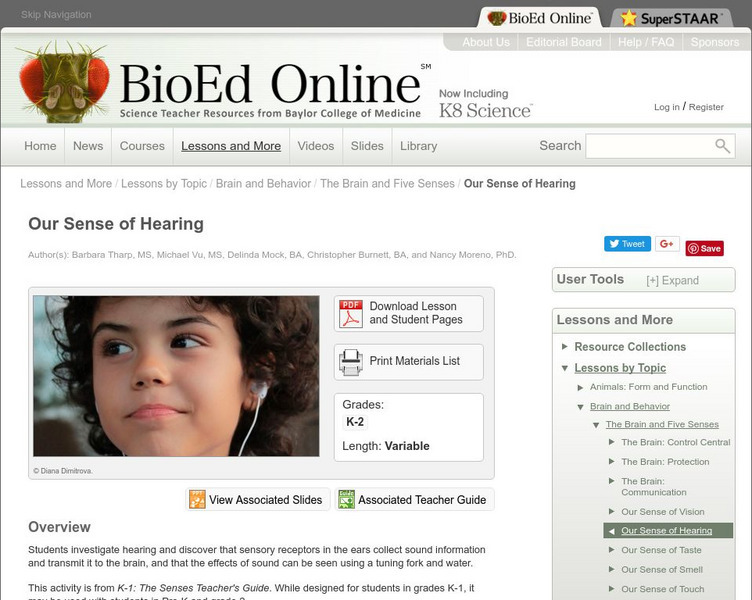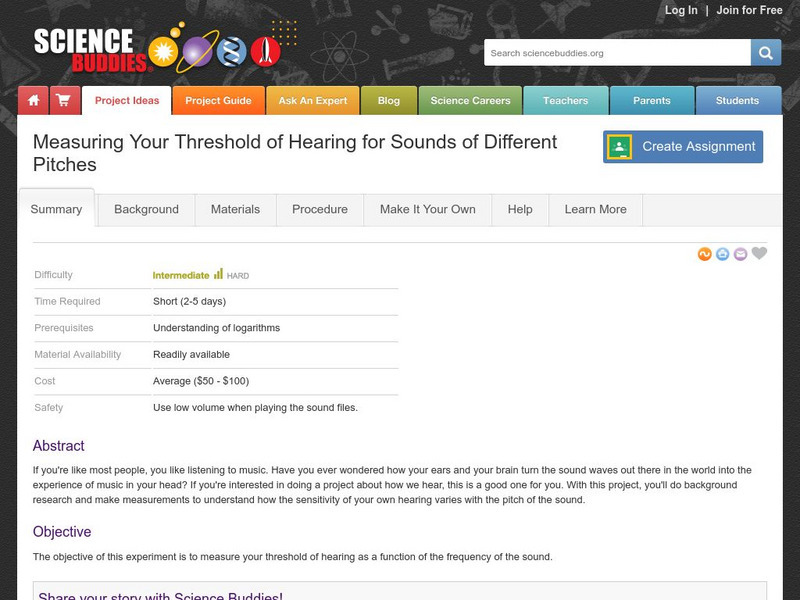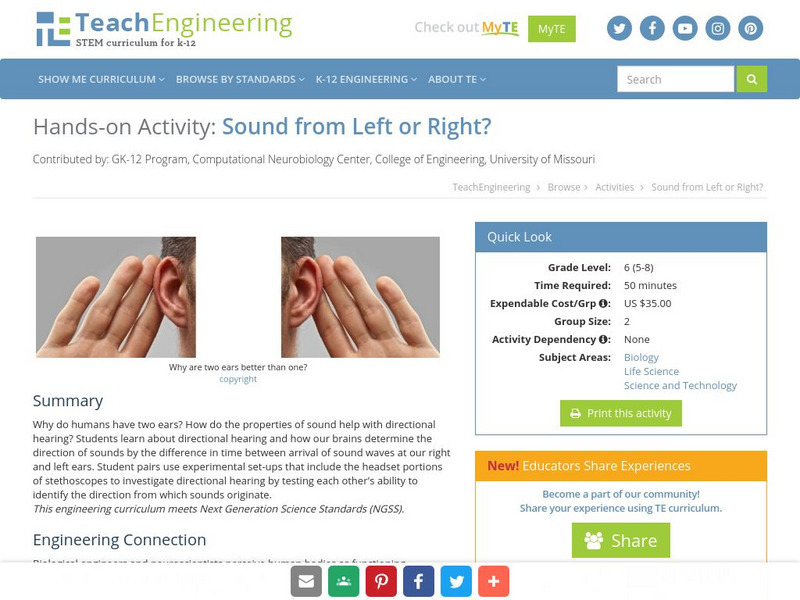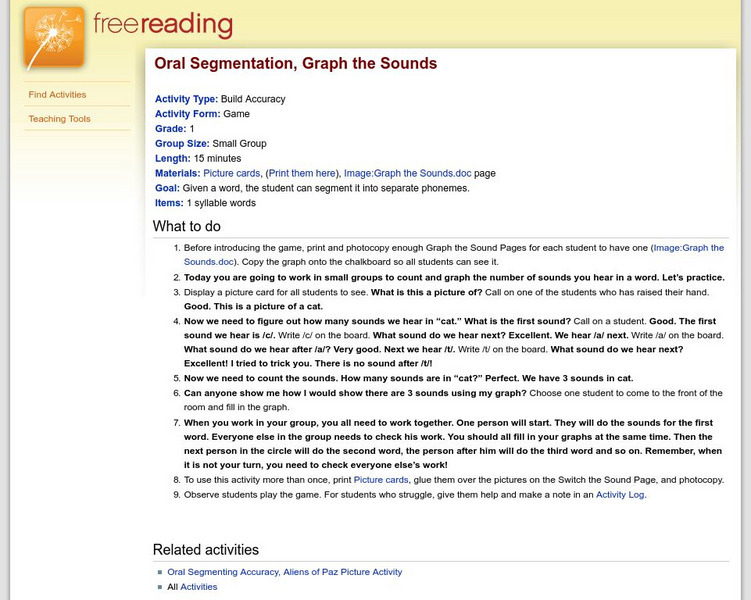Hi, what do you want to do?
BioEd Online
Bio Ed Online: Our Sense of Hearing
What causes sound? How do our ears detect sound? How do our brains recognize sound? In this lesson students investigate hearing and discover that sensory receptors in the ears collect sound information and transmit it to the brain, and...
Texas Education Agency
Texas Gateway: Physics of Hearing: Speed of Sound, Frequency, and Wavelength
By the end of this section, you will be able to define pitch; describe the relationship between the speed of sound, its frequency, and its wavelength; describe the effects on the speed of sound as it travels through various media; and...
Texas Education Agency
Texas Gateway: Physics of Hearing: Hearing
By the end of this section, you will be able to define hearing, pitch, loudness, timbre, note, tone, phon, ultrasound, and infrasound; compare loudness to frequency and intensity of a sound; and identify structures of the inner ear and...
Science Buddies
Science Buddies: Measuring Your Threshold of Hearing
How your ears and your brain turn the sound waves out there in the world into the experience of music in your head, remains a mystery to many, but yet we all experience and even enjoy sounds and music. If you're interested in doing a...
Texas Education Agency
Texas Gateway: Physics of Hearing: Sound Intensity and Sound Level
By the end of this section, you will be able to define intensity, sound intensity, and sound pressure level and to calculate sound intensity levels in decibels (dB).
University of Colorado
University of Colorado: Ph Et Interactive Simulations: Sound
This simulation lets you see sound waves. Adjust the frequency or volume and you can see and hear how the wave changes. Move the listener around and hear what she hears.
PBS
Pbs Learning Media: Moriussaq: A Case Study in Hearing Loss
This video segment follows neurophysiologist Allen Counter as he studies an epidemic of hearing loss in Moriussaq, Greenland, one of the quietest places on Earth. Footage from NOVA: "Mystery of the Senses: Hearing."
Texas Education Agency
Texas Gateway: Sound Interference and Resonance: Standing Waves in Air Columns
By the end of this section, you will be able to define antinode, node, fundamental, overtones, and harmonics; identify instances of sound interference in everyday situations; describe how sound interference occurring inside open and...
Project Britain
Primary Homework Help: Sound Quiz
Read some fast facts about sound energy first, then try a fourteen question review quiz. Check your answer after each question.
TeachEngineering
Teach Engineering: Sound From Left or Right?
Why do humans have two ears? How do the properties of sound help with directional hearing? Students learn about directional hearing and how our brains determine the direction of sounds by the difference in time between arrival of sound...
Texas Education Agency
Texas Gateway: Physics of Hearing: Problems and Exercises
This is a list of 84 problems and exercises to solve based on the content of Chapter 17: Physics of Hearing from the AP Physics online text.
Texas Education Agency
Texas Gateway: Physics of Hearing: Conceptual Questions
This is a list of 15 questions based on the major concepts presented in Chapter 17: Physics of Hearing from the AP Physics online text.
TeachEngineering
Teach Engineering: Sounds All Around
Students follow the steps of the engineering design process to create their own ear trumpet devices (used before modern-day hearing aids), including testing them with a set of reproducible sounds. They learn to recognize different...
TeachEngineering
Teach Engineering: How Does a Sound Sensor Work?
Students learn about how sound sensors work, reinforcing their similarities to the human sense of hearing. This lesson and its associated activity enable students to appreciate how robots can take sensor input and use it to make...
Curated OER
Kids Health: Let's Hear It for the Ear!
Use this site to learn about the body part that is responsible for collecting sounds, processing them and sending them to your brain. See all the inner workings of the ear through great diagrams. Available in Spanish.
Free Reading
Free Reading: Graph the Sounds: Oral Segmentation Activity
A small group activity. Each group receives a Graph the Sound page (link included on site). The teacher holds up a picture and the group must graph each sound they hear when they pronounce the word.
Other
Bscs: Sound Lesson 1: Sound Makers
How can you tell if something is making a sound? This lesson will show that to produce sound, an object must vibrate. Included are a minute-by-minute lesson plan, activities, and teacher discussion points and questions.
Unite for Literacy
Unite for Literacy: Healthy Me: I Hear
Look at all the things a child can hear and listen to each day. Book includes audio narration in 19 additional languages with text in English.
Other
Bscs: Content Background for Sound
This document will give you "extra" information and opportunities to build your understanding of sound so that you can be better prepared to facilitate the sound lessons with your students.
Other
Bscs: Sound Lesson 2: More Sound Makers: Do They Vibrate?
Do sound makers always vibrate? This lesson shows that all objects that produce sound vibrate, even if we cannot see or feel the vibrations. Included are a minute-by-minute lesson plan, activities, and teacher discussion points and...
National Institutes of Health
Nidcd: Noise Induced Hearing Loss
This site on Noise-Induced Hearing Loss runs through a variety of topics on the subject and includes a diagram. The topics covered include: How do we hear, What sounds cause NIHL, What are the effects of NIHL, Can NIHL be prevented, What...
Sophia Learning
Sophia: Vocab Tip: Hear It Said Out Loud
This video lesson focuses on the strategy of hearing unfamiliar vocabulary said aloud. The advantages of hearing it said aloud include activating prior knowledge and the brain remembering it better. It offers ways to learn the...
University of New South Wales (Australia)
University of New South Wales: School of Physics: Physclips: Human Sound
Get all the information you need to know about human sound in this learning module. Module covers voice production, ear's part in hearing, resonances, and pitch.
Texas Education Agency
Texas Gateway: Physics of Hearing: Sound
describe sound as a longitudinal wave.By the end of this section, you will be able to define sound and hearing and
Other popular searches
- Science Sound and Hearing
- Hearing and Sound
- Hearing and Sound Experiment
- Sound and Hearing Worksheets
- Hearing Sound Experiment
- Hearing Sound
- Hearing the Middle Sound
























